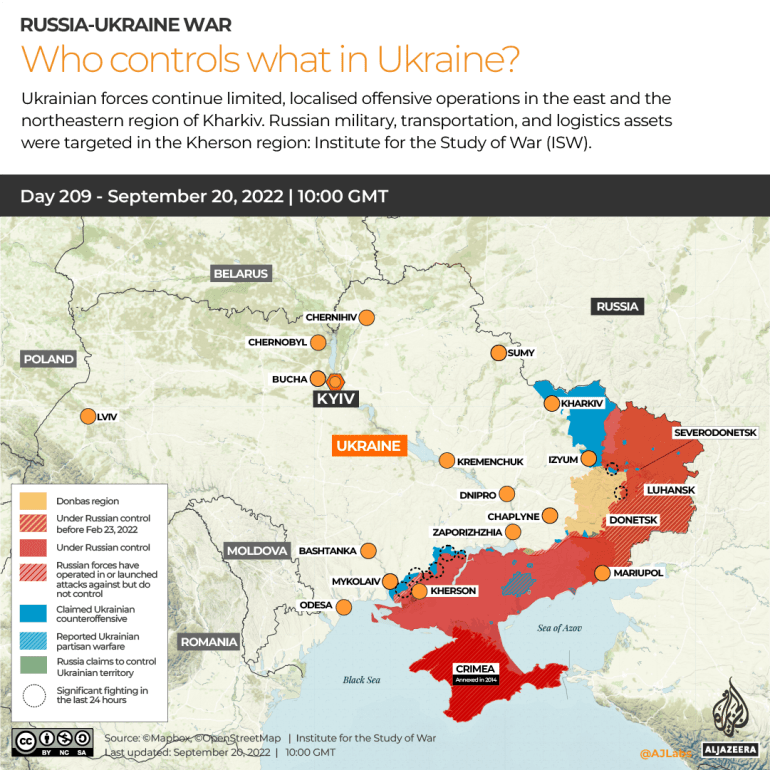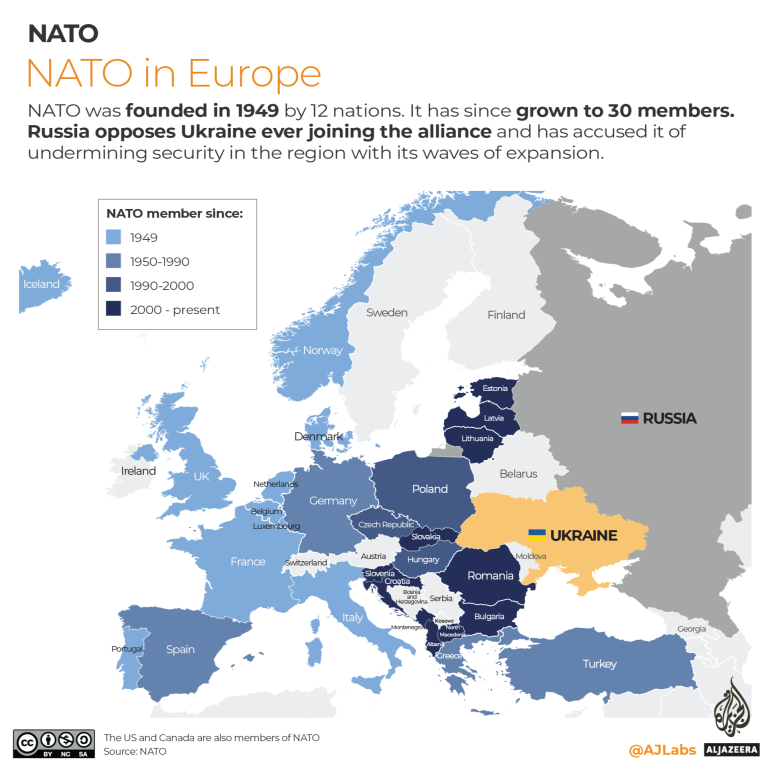Understanding Russia’s referendums in Ukraine
The Kremlin has used the tactic before as it held a hastily called referendum in Ukraine’s Crimea region in 2014.

Russian-backed separatists began holding referendums in the occupied areas of eastern Ukraine, a move that triggered a chorus of condemnation.
The vote will pave the way for the formal annexation of swaths of territory by Russia after nearly seven months of the war with its neighbour, a former Soviet republic.
Keep reading
list of 4 itemsUkraine troops focus on Donbas ‘de-occupation’ from Russia
Russian separatists in Luhansk convict ex-OSCE staff of treason
Missile hits near atomic plant; Zelenskyy says Russia ‘panicking’
Why are the referendums happening?
The Kremlin has used this tactic before. In 2014, it held a hastily called referendum in Ukraine’s Crimea region that also was denounced by the West as illegal and illegitimate. Moscow used the vote as a justification to annex the Black Sea peninsula in a move that was not recognised by most of the world.
On Tuesday, authorities in the separatist Luhansk and Donetsk regions that make up Ukraine’s eastern industrial heartland known as the Donbas abruptly announced that referendums on joining Russia. Moscow-backed officials in the Kherson and Zaporizhia regions in the south also called votes.
Who wants a referendum?
The self-styled Donetsk People’s Republic (DPR) and the Luhansk People’s Republic (LPR), which President Vladimir Putin recognised as independent states just before the invasion on February 24, have said they want referendums on joining Russia from September 23 to 27.
The Kherson and Zaporizhia regions, which are yet to be recognised as independent states by Russia, have also said they will hold their own votes.
Russia does not fully control any of the four regions, with only about 60 percent of the Donetsk region in Russian hands.
How much territory could Ukraine lose?
Russia controls more than 90,000sq km (34,750sq miles) of territory, or about 15 percent of Ukraine’s total area – roughly the size of Hungary or Portugal.
Russia annexed Crimea in 2014. With Crimea and the territory in the four other regions, Russia would gain an area about the same size as the US state of Pennsylvania.

What’s the significance?
As Moscow goes ahead with the referendums and includes the four regions in Russia, then Ukraine – and potentially its Western backers too – would, from a Russian perspective, be fighting against Russia itself.
That would raise the risk of a direct military confrontation between Russia and the NATO military alliance, a scenario that President Joe Biden has said could lead to World War III, because NATO members are supplying arms and giving intelligence to Ukraine.
As such, a rushed Russian move to formally annex another big chunk of Ukrainian territory would be a major escalation just days after potentially the most significant Russian battlefield defeat of the war in northeastern Ukraine.
Russia’s nuclear doctrine allows the use of such weapons if it is attacked with nuclear or other weapons of mass destruction, or if the Russian state faces an existential threat from conventional weapons.
Unless Ukraine agreed to stop fighting for its lost territory, Russia would have to commit significant military forces to defend the newly annexed regions – which are still not fully under Russian control.
Is the vote legitimate?
The five-day voting process will take place in the absence of independent monitors and offer ample room for rigging the outcome.
When the referendums were announced earlier this week, the West immediately questioned their legitimacy. US President Joe Biden and German Chancellor Olaf Scholz referred to them as shams, and French President Emmanuel Macron said they would have “no legal consequences.”
Ukrainian President Volodymyr Zelenskyy also called them “noise” to distract the public.

How is Russia’s troop mobilisation related?
A day after the referendums were announced, Putin ordered a partial mobilisation of reservists to bolster his forces in Ukraine.
The defence ministry said the mobilisation — Russia’s first since World War II — is intended to call up about 300,000 reservists with previous military experience. Observers noted, however, that Putin’s decree is broad enough to allow the military to swell the numbers if needed. Some reports suggest the Kremlin’s goal is amassing one million soldiers.
The Kremlin long has shunned taking such a deeply unpopular move, wary of fomenting discontent and eroding Putin’s support base.
The latest Ukrainian counteroffensive exposed Russia’s inability to control the 1,000-km (600-mile) frontline with its current limited force of volunteers. Military experts say it will take months to make the newly called-up reservists ready for combat.
What does Ukraine say?
Ukraine said the referendums were “naive blackmail” and a sign Russia was running scared.
“This is what the fear of defeat looks like. The enemy is afraid, and obfuscates primitively,” said Andriy Yermak, chief of staff to Zelenskyy.
Ukraine’s Foreign Minister Dmytro Kuleba said: “The Russians can do whatever they want. It will not change anything.”
Ukraine says it will not rest until every Russian soldier is ejected from its territory. Kyiv says it will never accept Russian control over its territory and has called on the West to supply more and better arms to fight Russian forces.
What happened in Crimea?
The conflict in eastern Ukraine began in 2014 after a pro-Russian president was toppled in Ukraine’s Maidan Revolution.
After Russian forces on February 27, 2014 took control of Crimea, which has an ethnic Russian majority and was transferred to Ukraine in Soviet times, a referendum on joining Russia was held on March 16.
Crimea’s leaders declared a 97 percent vote to secede from Ukraine and join Russia. Russia formally added Crimea on March 21, less than a month after the invasion.
Kyiv and the West said the referendum violated Ukraine’s constitution and international law.